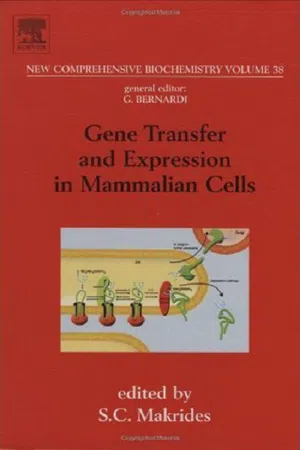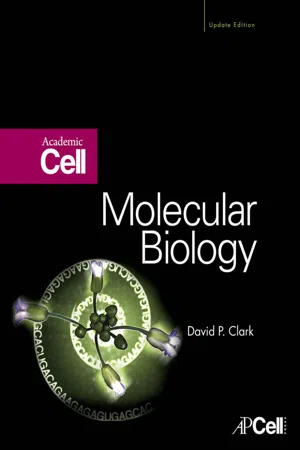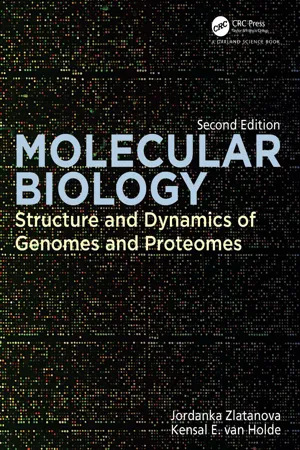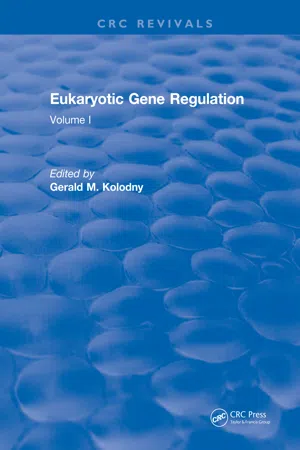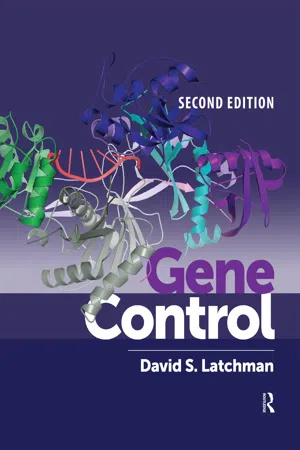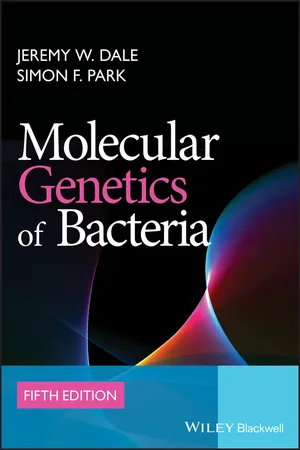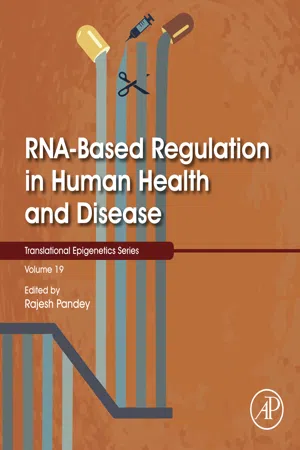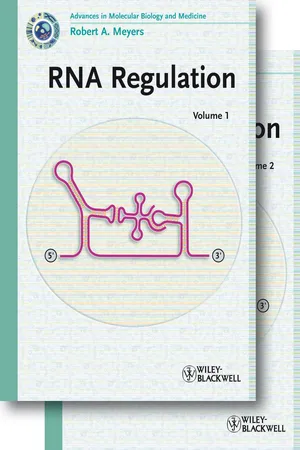Biological Sciences
Translational Regulation
Translational regulation refers to the control of gene expression at the level of protein synthesis. It involves the modulation of the rate at which mRNA is translated into proteins, often through the action of regulatory proteins or non-coding RNAs. This process plays a crucial role in regulating cellular functions and responses to environmental changes.
Written by Perlego with AI-assistance
Related key terms
10 Key excerpts on "Translational Regulation"
- eBook - ePub
- S.C. Makrides(Author)
- 2003(Publication Date)
- Elsevier Science(Publisher)
Translational Regulation in mammalian cellsMarilyn KozakAbstract Publisher SummaryDepartment of Biochemistry, Robert Wood Johnson Medical School, University of Medicine and Dentistry of New Jersey, 675 Hoes Lane, Piscataway, NJ 08854, USA; Tel.: +1-732-235-5355; Fax: +1-732-235-5356E-mail address: [email protected]Translational Regulation is important in determining when and where a protein is produced, how much is made, and in some cases, the actual structure of the protein. Because most control mechanisms operate during the early steps wherein the ribosome/factor complex assembles on the mRNA and selects the AUG start codon, the chapter focuses on the initiation phase of translation. It describes some regulatory mechanisms that operate during the elongation and termination phases. The simplest indication that translation might be regulated, i.e. a discrepancy between mRNA and protein levels, turns out sometimes to result from post-translational control mechanisms. These and other complications are discussed in the chapter.Abbreviations• eIF eukaryotic initiation factor • ER endoplasmic reticulum • 4E-BP1 eIF4E-binding protein 1 • FMRP fragile X mental retardation protein • HRI heme-regulated inhibitor • IRE iron response element • IRES internal ribosome entry sequence • IRP iron regulatory protein • LOX 15-lipoxygenase • m7G 7-methylguanosine • mTOR mammalian target of rapamycin • OGP osteogenic growth peptide • ORF(s) open reading frame(s) • PABP poly(A) binding protein • PERK ER-resident protein kinase • PKR double-stranded RNA activated protein kinase • rpS6 ribosomal protein S6 • S6K1 kinase targeted to rpS6 • TPO thrombopoietin • upORF(s) upstream open reading frame(s) • UTR untranslated region1 Introduction
Translational Regulation is important in determining when and where a protein is produced, how much is made and, in some cases, the actual structure of the protein. Because most control mechanisms operate during the early steps wherein the ribosome/factor complex assembles on the mRNA and selects the AUG start codon, the bulk of this review focuses on the initiation phase of translation. Near the end (Section 6 ), I describe some regulatory mechanisms that operate during the elongation and termination phases. The simplest indication that translation might be regulated, namely a discrepancy between mRNA and protein levels, turns out sometimes to result from post-translational control mechanisms. These and other complications are discussed briefly in the closing section. Translational perturbations that underlie human diseases are the subject of another review [1 - eBook - ePub
- David P. Clark(Author)
- 2009(Publication Date)
- Academic Cell(Publisher)
Regulation of gene expression at the level of transcription is most efficient in conserving materials and energy whereas regulation of enzyme activity provides the most rapid response. Since regulation at the level of translation is neither the most efficient nor the most rapid, it is consequently less frequent than these other forms of regulation. Generally, once mRNA has been made, it quickly moves to the ribosome where it is translated. This is especially true in prokaryotic organisms where there is no nuclear membrane restricting access between the transcription machinery and the ribosomes. It used to be thought that Translational Regulation was very rare. Partly this was due to the greater difficulty of measuring translation and associated phenomena such as mRNA stability rather than assaying transcription or protein levels. Consequently, more recent work has revealed a growing number of cases of regulation at the level of translation, especially in eukaryotes. In particular, plants seem to favor Translational Regulation via the use of small regulatory RNA molecules. Nonetheless, there are still significantly fewer known cases of translational than of transcriptional regulation.Regulation at the level of translation is rare in bacteria but more common in higher organisms.In addition to controlling the translation of mRNA after it has been made, there is also the possibility of aborting the synthesis of messenger RNA after transcription has been initiated and only a short stretch of RNA has been made. This somewhat ambiguous mechanism is referred to as transcriptional attenuation. It is sometimes classified as a form of transcriptional regulation. However, it has been included in this chapter as it is closely related to true Translational Regulation in the sense that alternative structures of messenger RNA are involved in both cases.Many of the known cases of Translational Regulation occur as extra steps in highly complex regulatory cascades that also include regulation at the level of transcription and of protein activity. Examples include the heat shock response in both bacteria and animals and the control of cell growth and differentiation in higher animals. In this chapter, we have attempted to illustrate regulation at the RNA level using examples where other regulatory mechanisms do not overly complicate the issue. - eBook - ePub
Protein Degradation with New Chemical Modalities
Successful Strategies in Drug Discovery and Chemical Biology
- Hilmar Weinmann, Craig Crews(Authors)
- 2020(Publication Date)
- Royal Society of Chemistry(Publisher)
CHAPTER 13 Targeting Translation Regulation for the Development of Novel DrugsIris Alroy,a * Wissam Mansourb and Yoni Sheinbergerba Anima Biotech, Inc., 75 Claremont Rd, Ste 102, Bernardsville, NJ 07924, USAb Anima Biotech, Ltd., 10 Hanechoshet St., Tel-Aviv, Israel 6971072*Corresponding author. Email: [email protected]13.1 IntroductionProtein synthesis is highly conserved across evolution, and all proteins, of all shapes and functions, are made by the same machinery, the ribosome. The central dogma that a gene is transcribed to one mRNA molecule which is then translated to one protein is no longer true as protein to mRNA ratio is greater or smaller than one for many proteins.1 Based on the diversity of cell types and tissues it was expected that the human genome will encode a much larger number of genes than finally identified in the Human Genome Project. Although alternative splicing gives an additional layer of complexity, it does not suffice to explain the complexity and the coordinated temporal and spatial cellular protein expression. mRNA transcription control was studied extensively and shown to be a complex and highly coordinated process, while neither the importance nor the mechanisms of Translational Regulation have been studied to the same extent. Indeed, recent studies have revealed that both the global protein synthesis rates and translational efficiencies of specific mRNAs are regulated in a cell- and tissue-specific manner.2 – 5Protein synthesis is shifting from seeing the process as a linear, mechanical translation of codons to viewing translation as an intricate regulatory system that controls where, when, how much and which proteins are synthesized in the cell, impacting gene expression no less than regulation of transcription. Concomitantly, regulatory elements of protein synthesis are emerging as valid novel drug targets, their prevalent house-keeping roles notwithstanding. This convergence reveals new opportunities for drug discovery in areas as varied as cancer, viral infections, fibrosis and neurodevelopmental diseases. - eBook - ePub
Molecular Biology
Structure and Dynamics of Genomes and Proteomes
- Jordanka Zlatanova(Author)
- 2023(Publication Date)
- Garland Science(Publisher)
Regulation of TranslationDOI: 10.1201/9781003132929-17Learning objectivesThe most general, nonspecific Translational Regulation involves controlling the number of ribosomes in the cell. We already know that the production of new ribosomes depends upon concerted synthesis of rRNA and ribosomal proteins (RPs, r-proteins). Synthesis of some bacterial ribosomal proteins is regulated by feedback control of r-protein operons. Ribosome numbers in bacteria can be controlled by degradation of the ribosome subunits released at the end of the translation cycle; this occurs if the subunits are not immediately re-used because of diminished need for translation. In eukaryotes, the fraction of the rRNA genes transcribed is regulated by chromatin structure and DNA methylation.Controlling initiation is the most rapid and specific way to regulate translation. In bacteria and phage, this often involves changes in the secondary structure of the mRNA. In eukaryotes, initiation control can be exerted by protein binding to the cap sequence, to internal ribosome entry sites, or to the 3′-UTR.A new concept introduced in this chapter is that of riboswitches, secondary structural elements in certain mRNAs whose conformation can respond directly to temperature, metabolites, or specific ions. Such conformational changes regulate ribosome accessibility to the message.Translation is also controlled by mRNA stability. The decay process begins with deadenylation and may then proceed through degradation from either the 5′- or the 3′-end. In eukaryotes, some mRNAs that have stalled in translation can be stored in stress granules; those destined for degradation are often found in processing particles known as P bodies. Finally, faulty mRNAs are destroyed by several mechanisms: a premature stop codon leads to nonsense-mediated decay, stalling of the ribosome along the message leads to no-go decay, and a missing stop codon leads to non-stop decay. - Buddhi Prakash Jain, Shyamal K Goswami, Tapan Sharma, Buddhi Prakash Jain, Shyamal K Goswami, Tapan Sharma(Authors)
- 2022(Publication Date)
- Academic Press(Publisher)
Chapter 3: Methods to study post-transcriptional regulation of gene expression
Tapan Sharma Department of Biochemistry and Molecular Pharmacology, University of Massachusetts Medical School, Worcester, MA, United StatesAbstract
Understanding the regulation of gene expression at the post-transcriptional level is a rapidly evolving area of research. Of late, many diseased conditions have been attributed to the dysregulation of gene expression at this stage. To have better insights into the causes behind such disorders, it is imperative to develop techniques to study the regulation and regulators of post-transcriptional gene expression. This chapter provides an overview of a few techniques that target specific modes of post-transcriptional regulation during events related to RNA splicing, stability, transport, and mRNA turnover, to name a few. Techniques evaluating microRNA expression and RNA–protein interactions have also been discussed in detail.Keywords
Gene regulation; Promoters; RNA binding proteins; Splicing; TranscriptionIntroduction
The central dogma of molecular biology was proposed by Sir Francis Crick in 1958 [1 ,2 ]. It was an explanation of how genetic information encoded in DNA is passed on to functional components called proteins with an intermediate messenger stage called RNA (Fig. 3.1 ). With the advancement in the field of molecular biology, this understanding has developed much beyond this simplistic model. It is now known that not all DNA encodes for proteins [3 ,4 ]. Only about 2% of the information in the genome of a eukaryotic organism is eventually converted to a translated protein sequence. The remaining 98% was initially considered as “junk DNA.” With the advent of high-throughput techniques, it was later discovered that nearly 80% of this junk is either actively transcribed to noncoding RNA (ncRNA) or is associated with histone modifications and chromatin structure [5- eBook - ePub
Eukaryotic Gene Regulation
Volume I
- Gerald M. Kolodny(Author)
- 2018(Publication Date)
- CRC Press(Publisher)
The problem encountered in cascade regulation has two aspects: (1) how is the regulative equilibrium of a given information carrier controlled at a specific level of transfer, and (2) what are the repercussions of such local regulative intervention on the whole system, not only “downstream” controlling the final expression of a given message, but also “upstream” in direction of the central memory. It is quite evident that although the flow of structural information is unidirectional, from the DNA to the protein, regulative information must be sent back to adjust, at any level of transfer, the rate and direction of flow as a function of demand at the periphery, i.e., in response to metabolic and physiological changes, whether they be programmed internally by the cell or imposed by the environment.Within the system of cascade regulation, a given message at any moment of its transfer through the cell must be able to receive signals which relate to the expression of its information and direct its further progress. Thus, retroactive controlling loops have not only to embrace phenotypic function and central memory but also the integrality of peripheral memories, i.e., the message during processing and transport. The local systems, i.e., the agents of control and their addressing sites in information-carrying molecules, must form local circuits which are interlinked in a manner that propagates throughout the whole system the repercussions of any disturbance in an individual local regulative equilibrium.A relatively well-known example of such circuits are the feedback mechanisms of control in prokaryotic cells. Present also in the machinery of bacterial protein synthesis due to the close coupling of transcription and translation in the DNA-mRNA-ribosome complex, these mechanisms allow not only the repressor/operator equilibirium to control translation but, reciprocally, allows any interference with peptide bond formation to have direct biochemical effects on transcription.24In view of the dissociation of the unique transcription/translation complex in the eukaryotic cell, the biochemical formulation of such feedback loops becomes correspondingly more difficult. Indeed, they would have to embrace, in spite of physical and temporal separation, all the consecutive biochemical reactions involved in transcription, processing, transport, and translation. - eBook - ePub
- David Latchman(Author)
- 2020(Publication Date)
- Garland Science(Publisher)
Post-transcriptional Regulation 7Introducation
The evidence discussed in Chapter 1 (Section 1.4 ), indicates that in mammals at least the primary control of gene expression lies at the level of transcription. However, a number of cases exist where changes in the rate of synthesis of a particular protein occur without a change in the transcription rate of the corresponding gene or where post-transcriptional controls operate as a significant supplement to transcriptional control. This indicates that in these cases regulatory processes are operating at the level of one or more of the post-transcriptional events described in Chapter 6 . Indeed, in some lower organisms post-transcriptional regulation may constitute the predominant form of regulation of gene expression.In the sea urchin, for example, the nuclear RNA contains many more different RNA species than are found in the cytoplasmic messenger RNA. A large proportion of the transcribed genes give rise to RNA products that are not transported to the cytoplasm and do not function as a messenger RNA. Interestingly, however, this process is regulated differently in different tissues; an RNA species which is confined to the nucleus (where it will ultimately be degraded) in one tissue, being transported to the cytoplasm and functioning as a messenger RNA in another tissue. Indeed, up to 80% of the cytoplasmic mRNAs found in the embryonic blastula are absent from the cytoplasmic RNA of adult tissues such as the intestine but are found in the nuclear RNA of such tissues.Although such post-transcriptional regulation in mammals does not appear to be as generalized as in the sea urchin, some cases exist where changes in cytoplasmic mRNA levels occur without alterations in the rate of gene transcription. Post-transcriptional regulation of this type may be more important in controlling variations in the level of mRNA species expressed in all tissues than in the regulation of mRNA species that are expressed in only one or a few tissues. For example, in the experiments of Darnell and colleagues, which demonstrated the importance of transcriptional control in the regulation of liver-specific mRNAs (see Chapter 1 , Section 1.4 - eBook - ePub
- Jeremy W. Dale, Simon F. Park(Authors)
- 2013(Publication Date)
- Wiley(Publisher)
This is achieved, in part, by autogenous control of translation, i.e. the accumulation of a ribosomal protein will repress the translation of the corresponding mRNA. This also provides a way of relating ribosomal protein production to the amount of rRNA. If there is a shortage of rRNA, free ribosomal proteins will start to accumulate, and will shut down further translation of the relevant mRNAs. In this way, the cell is able to respond to changes in growth conditions. When the cells are short of nutrients, they need fewer ribosomes. This can be achieved by reducing rRNA production, with a consequent cessation of ribosomal protein production. This is one aspect of what is known as the stringent response. The stringent response is triggered by amino acid starvation, which leads to the presence of uncharged tRNA occupying the A site of the ribosome. A protein known as the stringent factor is involved in the conversion of GTP to two unusual nucleotides, ppGpp (guanosine-5′-diphosphate-3′-diphosphate) and pppGpp (guanosine-5′-triphosphate-3′-diphosphate). These nucleotides prevent transcription of the rRNA operons; the production of ribosomal proteins will then be reduced as a consequence of the reduced amount of rRNA available. 3.3.4 Regulatory RNA RNA has very well-established functions in the bacterial cell, acting as mRNA, tRNA and rRNA. It is now known to also play important roles in the regulation of gene expression by bringing about changes in the level of translation or transcription, or by influencing mRNA stability. These so-called regulatory RNAs act through a number of different mechanisms, for example by inducing changes in RNA confirmation, through binding to proteins, via base-pairing with other RNA molecules, or by interacting with DNA. The first regulatory mechanism to be discovered was that of attenuation, which was discovered decades ago, but only in the past decade has the importance and prevalence of regulatory RNA been fully appreciated. In E - eBook - ePub
- (Author)
- 2020(Publication Date)
- Academic Press(Publisher)
Chapter 4: The dynamic aspects of RNA regulation
Ravi Shankar∗Biotechnology Division, CSIR-Institute of Himalayan Bioresource Technology, Palampur, HP, India ∗ Corresponding authorAbstract
With rise of various high throughput approaches and landmark projects like Human Genome Project, ENCODE and FANTOM, our understanding about RNA universe has changed like never before. With hardly 2% of the genome coding for proteins and most of the multicellular eukaryotes displaying almost equal number of protein coding genes, it is clear that regulatory system provided by the so called “junks” of genome is much more critical than the protein coding genes themselves in shaping the fate of cells. Right from their transcription, the RNAs display a high level of coordinated acts of regulation, processing and interactions which in turn become regulatory themselves. RNAs are capable to provide variable regulatory modes just by switching their structures which could be done alone or with help of interacting partners in form of some proteins or RNAs. The present chapter has discussed all these regulatory factors in the life of an RNA where many times the RNA itself is a regulator.Keywords
Regulatory; Functional; Non-coding; Factor; RBP; InteractionIntroduction
If the Human Genome discovery was one of the biggest achievements in modern biology, success of projects like ENCODE (Encyclopedia of DNA Elements) is no less which challenged our concept of genes and obsession with proteins [1 ]. It taught us the existence of much bigger world beyond protein coding RNAs. In fact, the process of protein coding itself now appears very much dependent upon various regulatory mechanisms than previously appreciated.Today, there are much larger number of various types of RNA molecules than proteins. The degree of variability and control level provided by RNAs has gone much beyond the proteins. Our understanding of RNA universe earlier existed around mRNA and t-RNA duet and orchestra of snoRNAs, snRNAs and various ribosomal RNAs, basically all centered around process of translation and our overt emphasis on the importance of proteins in our life. Yet, the period between the mid of 1990s and beginning of new millennium started making ways for much broader thinking and some remarkable studies, giving emphasis on the noncoding elements and RNA universe. One big reason for this appears to be the Human Genome project itself where one had expected to see a number of protein coding genes, but surprisingly it remained restricted to a number which is almost same in most of other multicellular eukaryotes. It also revealed that just 2%–3% protein coding regions exist, and we are almost 99% similar to Chimpanzee with such protein coding gene set [2 ]. Very shortly it was realized that there is much more than the protein coding regions in our lives. The obsession with proteins prior to HGP started looking more like absurdity. Things which were called “junk” by protein obsessed world were now emerging as the “goldmines” and “king-makers” of genome. Work with repetitive elements in Human Genome had already started proving that. In 2003, with initial target of 1% of non-coding regions of the Human Genome, ENCODE project was launched. The findings of ENCODE project was going to challenge our most fundamental understandings in molecular biology, including the definition of “Gene” itself [3 - eBook - ePub
- Robert A. Meyers(Author)
- 2014(Publication Date)
- Wiley-Blackwell(Publisher)
The majority of regulatory RNA elements known in bacteria are embedded within the 5′UTRs of mRNAs, and will be referred to here as “r5′UTRs” (where “r” indicates “regulatory”), as suggested previously [43]. The r5′UTRs modulate the expression of their downstream protein coding sequence by affecting transcription elongation (also referred to as “transcription attenuation”), translation efficacy, or RNA stability [44, 45]. The regulatory effects of r5′UTRs rely on two mutually exclusive conformational structures (“conformers”): one which imposes the effect; and another which is silent. The switch from one conformer to the other is mediated by a signal that is specifically detected or bound by the r5′UTR. This signal may be of a physico-chemical nature (e.g., temperature, pH, ionic strength), a metabolite (i.e., small organic compounds), or a transfer RNA (tRNA). Diverse classes of r5′UTRs can be distinguished according to the nature of the signal sensed, although a current “semantic drift” tends to nominate all r5UTRs as “riboswitches” (see Ref. [44]; this distinction will be maintained in this chapter). Generally, r5′UTRs responding to the same signal are common to mRNAs of different genes (e.g., riboswitches), and in many cases a functional relationship exists between proteins encoded by these mRNAs and the signal to which their 5′UTRs respond. For instance, the signal may be a metabolite and the mRNAs encode for transporters or enzymes belonging to metabolic pathway using this metabolite. Such functional interplays, based on direct interactions between signals and mRNAs, give rise to regulatory feedback loops and the orchestration of genetic programs. The fact that gene expression control via r5′UTRs is found in the three kingdoms of life suggests an ancestral mode of regulation that has evolved a sequence diversity allowing the orchestration of numerous fundamental biological functions in a robust manner; indeed, more than 4% of bacterial genes are believed to have a r5′UTR-controlled expression [44–50].3.1 Regulatory 5′UTRs Sensing Physico-Chemical Cues
The folding dynamics of an RNA molecule relies on hydrogen bonds, and changes in the physico-chemical parameters capable of affecting such bonds (e.g., temperature, pH, osmolarity) should also impact on the RNA function.3.1.1 RNA Thermometers to Adjust Global Physiology
An ability to sense and respond to temperature is a universal cellular process, and most forms of macromolecule (e.g., DNA, RNA, proteins, lipids) have evolved structural domains that are capable of sensing temperature variations [51–55]. The different structural elements identified within RNA thermometers all feature a common functional pattern [56]. RNA thermometers are r5′UTRs that affect translation due to alternative foldings that either occlude, or not, the ribosome binding site (RBS) and, more specifically, the Shine–Dalgarno (SD) sequence and/or the translation initiation codon (“AUG”). At nonpermissive temperatures, the secondary structures trap the RBS into a double-stranded RNA helix that prevents its utilization by the ribosome; at permissive temperatures, the RBS is not involved in the secondary structure and translation can occur (Fig. 1 ). Among RNA thermometers, rpoH and cspA mRNAs respond to heat-shock and cold-shock, respectively, and are widespread across bacterial species as they ensure essential adaptations in response to temperature. These regulatory RNA systems have been studied in great detail through elegant experimental approaches in E. coli [57–61]. The rpoH mRNA encodes the sigma factor RpoH (σ32 or σH ) that controls the transcription initiation of genes belonging to the heat-shock regulon. This regulon contains more than 100 genes, including those that are essentially involved in protein damage control and folding; this forces the cell to keep RpoH under sharp regulation to cope with vital demands. Following a heat-shock, RpoH levels are increased as a result of an increased stability of the protein and an enhanced translation of the rpoH mRNA. The thermocontrol operating on rpoH mRNA translation is due to a complex folding of the RNA region that extends from − 19 to + 247 nt relative to the AUG of rpoH. In vitro, this complex secondary structure is not used by the ribosome at low temperature (30°C), but at high temperature (42°C) the ribosome forms an efficient translation initiation complex, demonstrating that the RNA structure is sufficient to mediate the thermocontrol without any additional factor. In vivo, genetic analyses have established that a temperature upshift transiently melts the secondary structure of rpoH
Index pages curate the most relevant extracts from our library of academic textbooks. They’ve been created using an in-house natural language model (NLM), each adding context and meaning to key research topics.
